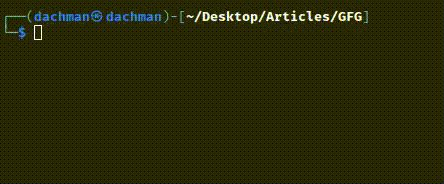Node.js 是一個開源的服務器端運行時環境。讀取和寫入是任何應用程序的兩個主要重要函數。 Node.js 提供了廣泛的內置函數來執行讀寫操作。這fs包中包含文件操作所需的函數。
filehandle.readLines() 是 NodeJs 中的內置函數。該函數從文件中逐行讀取。
用法:
filehandle.readLines();
參數:該函數沒有任何參數。
返回值:該函數返回readline.InterfaceConstructor
注意:在運行此程序之前,將此文本添加到 gfg.txt 文件中。
Hey GeekforGeeks A computer science portal for geeks
示例 1:在這個例子中,我們將看到文件句柄.readLines()函數。
JavaScript
const { open } = require('node:fs/promises');
(async () => {
const file = await open('./gfg.txt');
for await (const line of file.readLines()) {
if (line.includes('science')) {
console.log(line);
}
}
})();輸出:

示例 2:在本程序中,我們將通過不同的方式使用此方法。
JavaScript
const { open } = require('node:fs/promises');
(async () => {
const file = await open('./gfg.txt');
let scienceLines = 0;
let nonScienceLines = 0;
let searchVariable = "gfg";
for await (const line of file.readLines()) {
if (line.includes(searchVariable)) {
scienceLines++;
} else {
nonScienceLines++;
}
}
console.log(`Number of lines containing
${searchVariable}: ${scienceLines}`);
console.log(`Number of lines not containing
${searchVariable}: ${nonScienceLines}`);
})();輸出:

結論: filehandle.readLines() 函數用於在 Node.js 中逐行讀取文件,返回一個異步迭代,允許對文件的行進行方便的迭代。通過利用 filehandle.readLines(),開發人員可以輕鬆地逐行處理大文件,從而實現高效的數據處理,而無需將整個文件一次性加載到內存中。當處理太大而無法完全放入內存的文件或以非阻塞方式異步處理文件時,它特別有用。
參考: https://nodejs.org/api/fs.html#filehandlereadlinesoptions
相關用法
- Node.js filehandle.readFile()用法及代碼示例
- Node.js filehandle.read()用法及代碼示例
- Node.js filehandle.close()用法及代碼示例
- Node.js filehandle.truncate()用法及代碼示例
- Node.js filehandle.appendFile()用法及代碼示例
- Node.js fs.rename()用法及代碼示例
- Node.js fs.statSync()用法及代碼示例
- Node.js fs.truncate()用法及代碼示例
- Node.js fs.mkdir()用法及代碼示例
- Node.js fs.existsSync()用法及代碼示例
- Node.js fs.exists()用法及代碼示例
- Node.js fs.readFile()用法及代碼示例
- Node.js forEach()用法及代碼示例
- Node.js fs.renameSync()用法及代碼示例
- Node.js fs.stat()用法及代碼示例
- Node.js fs.rmdir()用法及代碼示例
- Node.js fs.mkdirSync()用法及代碼示例
- Node.js fs.open()用法及代碼示例
- Node.js fs.realpath()用法及代碼示例
- Node.js fs.mkdtempSync()用法及代碼示例
- Node.js fs.createReadStream()用法及代碼示例
- Node.js fs.write()用法及代碼示例
- Node.js fs.openSync()用法及代碼示例
- Node.js fs.rmdirSync()用法及代碼示例
- Node.js fs.readdir()用法及代碼示例
注:本文由純淨天空篩選整理自neeraj3304大神的英文原創作品 Node.js filehandle.readLines() Method。非經特殊聲明,原始代碼版權歸原作者所有,本譯文未經允許或授權,請勿轉載或複製。
